How have changes to coregonine spawning habitat influenced reproductive success?
Contributing Authors
Brian Weidel (USGS, bweidel@usgs.gov), Brian Lantry (USGS), Alexander Gatch (USFWS), Ryan Walquist (USGS), Josephine Johnson (USFWS), Dimitri Gorsky (USFWS), Michael Connerton (NYSDEC), Brian O’Malley (USGS), Peter Esselman (USGS), James McKenna (USGS), Zy Biesinger (USFWS)
Executive Summary
Lake Ontario’s Cisco, Coregonus artedi, and Lake Whitefish, Coregonus clupeaformis populations have declined for centuries and surveys suggest populations are impeded during early life stages. This project
developed methods to quantify habitat specific coregonine egg survival. We then contrasted egg survival on current, potentially degraded, spawning substrates with experimentally added clean rock substrates to test
how spawning habitat changes may have influenced reproductive success. Multiple years of surveys have shown in Lake Ontario’s Chaumont Bay, Cisco and Lake Whitefish specifically spawn over shallow (2 – 4
m) regions of substrates where limited interstices exist (rock and dreissenid mussel substrates). Hard substrate with interstitial spaces is rare and generally shallow in Lake Ontario due to centuries of land use
and eutrophication, sedimentation and dressenid shells which have embedded most interstices. When coregonines spawn in late November and December over habitats with limited interstices, the near neutrally
buoyant eggs are easily disturbed by wave action, and often are displaced onto deeper, silt substrates. Eggs incubate overwinter and in April, bottom-set emergence traps catch recently hatched larvae as they swim to surface waters. Emergence trap catches are greatest on the shallow, hard substrates where eggs deposition peaks but are rare on deeper silt habitats. In summer 2022, limestone rock was added to create four
experimental sites with deep interstices at differing depths (~ 2, 3, 4, 6 m) on a known spawning site (Chaumont Bay’s Middle Shoal) and natural rates of egg deposition and larval emergence were measured
on experimental and control sites over two years. In December 2022, egg deposition was lower on the added substrate relative to the surrounding area (63% less for Cisco, 86% less for Lake Whitefish). Despite lower egg deposition, larval emergence was 20 times greater on the added substrate relative to the control sites. In the second spawning season (December 2023) Cisco egg deposition was similar between the experimental and control sites. On average, 15% and 13% of Cisco and Lake Whitefish eggs survived on the experimental, high interstice substrate sites relative to 0.2% and 0.7% on the adjacent, degraded control
substrate sites. This study is the first to quantify habitat specific egg survival for Coregonus species. Our results demonstrate the negative effect that interstitial habitat degradation can have on coregonine spawning
success and the potential benefits of substrate remediation.
